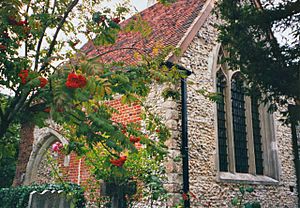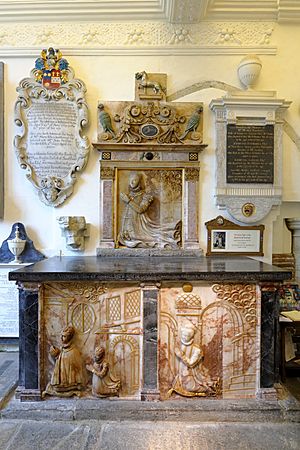Lumley Chapel facts for kids
Quick facts for kids Lumley Chapel |
|
|---|---|

The Lumley Chapel from the southeast
|
|
| Lua error in Module:Location_map at line 420: attempt to index field 'wikibase' (a nil value). | |
| OS grid reference | TQ 243 638 |
| Location | Cheam, London Borough of Sutton |
| Country | England |
| Denomination | Anglican |
| Website | Churches Conservation Trust |
| History | |
| Former name(s) | St Dunstan's Church, Cheam |
| Dedication | Saint Dunstan |
| Architecture | |
| Functional status | Redundant |
| Heritage designation | Grade II* |
| Designated | 28 August 1953 |
| Architectural type | Church |
| Style | Norman, Gothic |
| Closed | 1864 |
| Specifications | |
| Materials | Roughcast stone and brick Tiled roof |
The Lumley Chapel is a historic Anglican church building in the village of Cheam, part of the London Borough of Sutton in England. It is no longer used for regular church services, which is why it's called a redundant church. Because of its historical importance, it is a Grade II* listed building. This means it is officially protected.
The chapel is cared for by the Churches Conservation Trust, a charity that looks after historic churches. It stands in the churchyard of the newer St Dunstan's Church. The Lumley Chapel is the oldest building still standing in the London Borough of Sutton.
Contents
History of the Chapel
The story of the chapel begins a very long time ago. The Archbishop of Canterbury was given the land in Cheam in 1018. It's believed the first church was built here soon after. It was named after Saint Dunstan, who was once an Archbishop of Canterbury.
Over the centuries, the church changed. In the 12th century, a side section called an aisle was added. A major change happened in the 1590s because of a man named John Lumley, 1st Baron Lumley. He inherited the famous Nonsuch Palace nearby when he married Lady Jane Fitzalan. Lord Lumley decided to turn the church into a special memorial chapel for himself and his two wives.
By the 18th century, the church had a main hall (the nave), a side aisle, and a tower. Around 1746, the church was made bigger. But by the 1860s, the local community needed an even larger church. So, in 1864, a new St Dunstan's Church was built right next to it.
Most of the old church was then knocked down. However, the east end, which held all the beautiful tombs and memorials that Lord Lumley had created, was saved. This part became what we now call the Lumley Chapel.
Architecture and Design
The chapel is built from a mix of rough stone and brick, with a tiled roof. It shows its age through its different parts. The east window, with its three sections of glass, was made in the 15th century.
If you look at the walls, you can see clues about the chapel's past. On the south wall, you can see the outline of a blocked-up archway. This is where the old south chapel used to be. On the north wall, there are small pieces of a blocked window that might be from the Saxon or early Norman times, over 900 years ago!
Inside, the walls are covered in plaster. Near the ceiling, there is a decorative strip called a frieze with carvings of fruit and leaves. Above that is a curved ceiling called a barrel vault, which is decorated with patterns and hanging ornaments.
Famous Memorials

The chapel is most famous for the amazing tombs of Lord Lumley and his family. These are made from beautiful alabaster and marble.
- Lady Jane Fitzalan's Tomb: Jane was Lord Lumley's first wife. She died in 1578. Her tomb is decorated with family coats of arms. It also has carvings of her three children praying in the chapel of Nonsuch Palace.
- Lord John Lumley's Tomb: Lord Lumley died in 1609. His tomb is also very grand and covered in heraldry, which are symbols representing his family.
- Elizabeth Darcy's Tomb: Elizabeth was Lord Lumley's second wife. She died in 1617. Her tomb has a life-sized statue of her lying down, which is called a recumbent effigy.
There are also memorials to other important local families, like the Pybus and Antrobus families. Another interesting memorial is for James Boevey, a merchant and philosopher who lived in the 17th century. On the floor, you can find old brass plaques, called brasses, that date from between 1450 and 1632.
Around the Chapel
The Lumley Chapel sits in the churchyard of the newer St Dunstan's Church, which is still used for services today. This new church is also a Grade II* listed building. The churchyard has a special covered gate called a lychgate, which was built in 1891. There are also several old tombs in the churchyard that are historically listed and protected.
Gallery
See also







